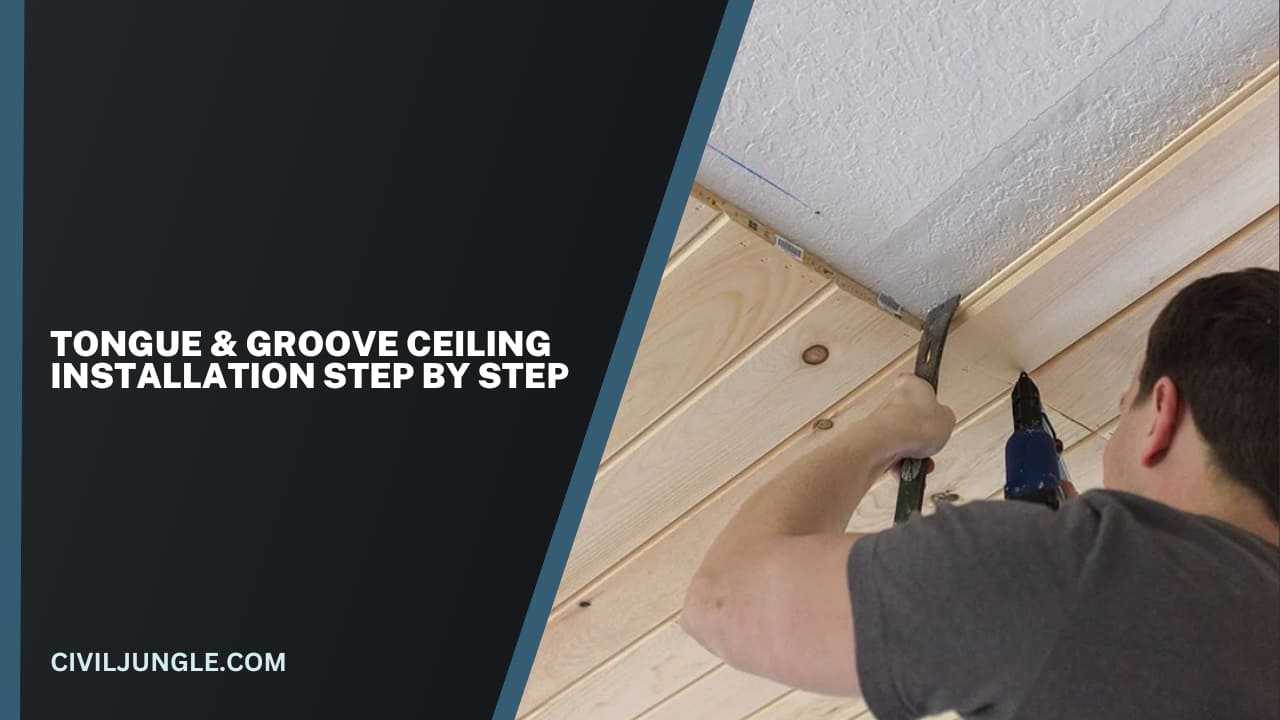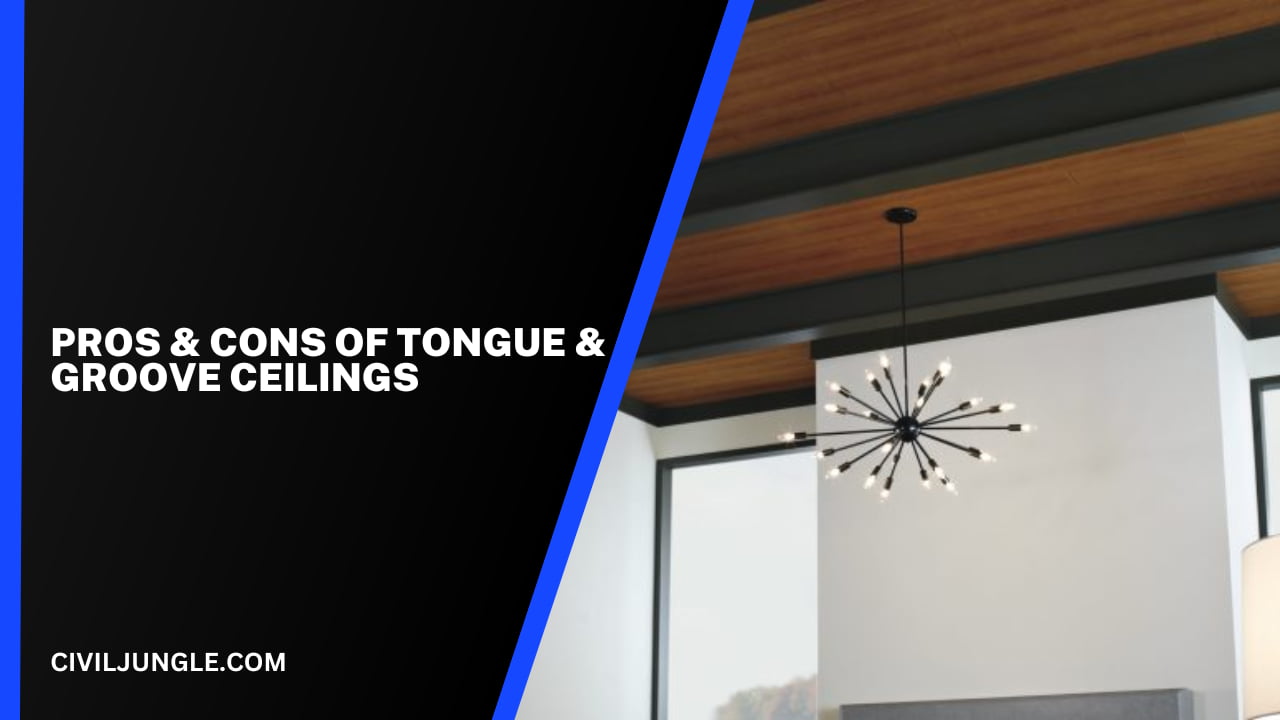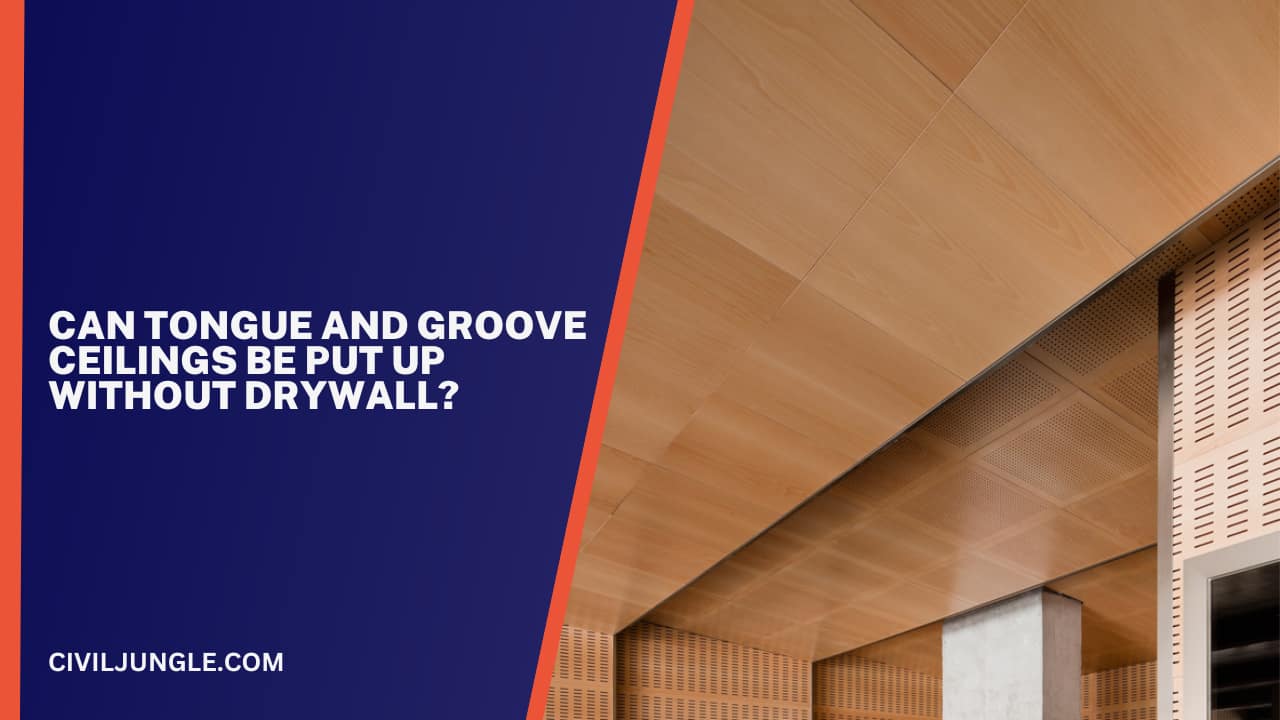What Is Tongue And Groove Ceiling?
Important Point
Tongue and groove ceiling is a popular design choice that has been used for centuries in both residential and commercial buildings. It is a type of interior ceiling finish that is characterized by interlocking panels, with one panel having a protruding tongue that fits into a groove on the adjacent panel. The result is a smooth, flat surface that provides an elegant and cohesive look to any space.
The use of tongue and groove ceilings can be traced back to the 18th century, when it was a common feature in colonial-style homes. These days, it is a popular design choice for modern homes as well, as it can give a room a warm, inviting and rustic look. It can also be used in a more contemporary setting to create a modern, sleek finish.
Tongue and groove ceilings come in a variety of materials, including wood, PVC, and MDF. Each material has its own unique benefits and drawbacks, and the choice of material depends on the intended use, budget and personal preferences.
One of the main advantages of tongue and groove ceilings is their ability to provide a seamless, uniform look. Unlike other ceiling finishes, such as drywall or stucco, which can show visible seams, tongue and groove ceilings provide a smooth and unbroken surface. This can help create an illusion of a higher ceiling, making the room feel more spacious and airy.
In addition to its aesthetic appeal, tongue and groove ceilings also provide functional benefits. For instance, the interlocking panels create a strong and durable finish that can withstand moisture and humidity. This makes it ideal for use in high-moisture areas, such as bathrooms and kitchens, where traditional drywall can become damaged over time.
Another benefit of tongue and groove ceilings is their ease of installation. While it may be possible to install a tongue and groove ceiling on your own, it is recommended that you hire a professional to ensure that the installation is done correctly.
A professional will be able to provide expert advice on the best materials and techniques to use, and will ensure that finished product is both attractive and functional.
When selecting the material for a tongue and groove ceiling, it is important to consider cost, durability, and aesthetic appeal of the material. One of the most popular materials used for tongue and groove ceilings is wood. Wood is a classic and timeless material that can provide warmth and character to any space. It is also a durable material that can withstand wear and tear over time.
There are several types of wood that are commonly used for tongue and groove ceilings, including pine, cedar, and redwood. Pine is a popular choice due to its affordability and versatility, and it is often used in rustic and traditional settings.
Cedar is a more durable option that can resist decay and insect damage, and is often used in outdoor applications. Redwood is a luxurious and expensive option that provides a rich, warm finish, and is often used in high-end homes and commercial settings.
While wood is a popular option, it is not without its drawbacks. Wood can be susceptible to warping and splitting over time, and it may require regular maintenance to ensure that it remains in good condition. In addition, wood may not be the best option for areas with high humidity or moisture, as it can absorb moisture and become damaged over time.
PVC and MDF are two alternative materials that are becoming increasingly popular for tongue and groove ceilings. PVC is a lightweight and durable material that is resistant to moisture and humidity, making it ideal for use in high-moisture areas. It is also affordable and easy to install, making it a great option for DIY projects.
MDF, or medium-density fiberboard, is another popular option that is made from compressed wood fibers. It is a versatile and affordable material that can provide a smooth, flat finish.
How To Install Tongue And Groove Ceiling?
Installing a tongue and groove ceiling can be a great way to add character and warmth to a room. While the process can be time-consuming and may require some woodworking skills, it is possible to install a tongue and groove ceiling on your own with the right tools and techniques. In this article, we will go over the steps involved in installing a tongue and groove ceiling.
Step 1: Measure and Plan
Before you begin the installation process, it is important to measure the area where the tongue and groove ceiling will be installed.
This will help you determine how much material you will need and how many panels will be required. It is also important to plan the layout of the panels to ensure that they are spaced evenly and look aesthetically pleasing.
Step 2: Choose the Material
Once you have measured and planned the installation, it is time to choose the material for the tongue and groove ceiling. As mentioned in the previous article, there are several options to choose from, including wood, PVC, and MDF.
Each material has its own unique benefits and drawbacks, so it is important to consider the intended use, budget, and personal preferences when making a decision.
Step 3: Install the Furring Strips
Before installing the tongue and groove panels, it is important to install furring strips. These are thin wooden strips that are attached to the ceiling joists to provide a stable base for the panels. The furring strips should be installed perpendicular to the joists and spaced no more than 16 inches apart.
Step 4: Install the First Panel
Once the furring strips are installed, it is time to install the first tongue and groove panel. The panel should be placed with the groove facing the wall, and the tongue facing outward.
The panel should be aligned with center of room and nailed into the furring strips using finishing nails. The nails should be driven at a 45-degree angle through the tongue of the panel to ensure a secure fit.
Step 5: Install the Remaining Panels
After installing the first panel, it is time to install the remaining panels. The tongue of each panel should be inserted into groove of previous panel, and panel should be nailed into the furring strips. The process should continue until the entire ceiling is covered with tongue and groove panels.
Step 6: Cut and Install the Last Row
When you reach the last row of panels, it may be necessary to cut them to fit the remaining space. To do this, measure space between the last installed panel and the wall, and mark the measurement on the last panel. Use a saw to cut the panel to the correct size, and install it as you did the previous panels.
Step 7: Finish the Ceiling
Once all of the panels are installed, it is time to finish ceiling. This may involve sanding any rough edges or applying a stain or paint to the panels. If you choose to stain or paint the panels, it is important to follow the manufacturer’s instructions and apply the product evenly and in a well-ventilated area.
Installing a tongue and groove ceiling can be a great DIY project for those with some woodworking skills and the right tools. While the process may be time-consuming, the end result can be a beautiful and functional addition to any room.
Remember to measure and plan carefully, choose the right material, install the furring strips, and nail the panels securely into place. With a little patience and attention to detail, you can create a stunning tongue and groove ceiling that will add character and warmth to your home.
Also, Read : How to Get Free Land in US?
The Tools Needed To Install Tongue And Groove Ceiling
Installing a tongue and groove ceiling can be a great way to add character and warmth to a room, but it requires the right tools to get the job done. In this article, we will discuss the tools needed to install a tongue and groove ceiling.
- Measuring Tape: The first tool you will need is a measuring tape. This will be used to measure the length and width of the ceiling, as well as the spacing of the furring strips and tongue and groove panels.
- Saw: A saw is essential for cutting tongue and groove panels to the correct size. There are several types of saws that can be used for this purpose, including a circular saw, a miter saw, or a table saw. It is important to choose a saw that is appropriate for the material being used and that has a sharp blade to ensure clean cuts.
- Level: A level is essential for ensuring that the tongue and groove panels are installed evenly and that the ceiling is level. A bubble level can be used to ensure that the panels are straight, and a laser level can be used to ensure that the ceiling is level.
- Nail Gun or Hammer: A nail gun or hammer is essential for attaching the tongue and groove panels to the furring strips. A nail gun is faster and more efficient, but a hammer can also be used if a nail gun is not available.
- Finishing Nails: Finishing nails are used to attach the tongue and groove panels to the furring strips. They should be long enough to penetrate through the tongue of the panel and into the furring strip, but not so long that they penetrate through the panel and into the ceiling joist.
- Chalk Line: A chalk line is used to create straight lines on the ceiling, which can be helpful for ensuring that the panels are installed evenly. It can also be used to mark the location of the furring strips and the panels.
- Sander: A sander can be used to smooth any rough edges or uneven surfaces on the tongue and groove panels. This can help to ensure that the panels fit together snugly and create a smooth, even surface.
- Safety Gear: When using power tools, it is important to wear appropriate safety gear. This may include safety glasses, gloves, and ear protection. It is also important to work in a well-ventilated area and to take breaks as needed to avoid fatigue and overheating.
- Caulk: Caulk can be used to fill any gaps between the tongue and groove panels or between the panels and wall. This can help to create a seamless, finished look and can help to prevent drafts and moisture from entering the room.
- Stain or Paint: If you choose to stain or paint the tongue and groove panels, you will need a brush or roller to apply the product. It is important to choose a high-quality stain or paint that is appropriate for the material being used and to apply the product evenly and in a well-ventilated area.
In conclusion, installing a tongue and groove ceiling requires a variety of tools to ensure that the job is done correctly and efficiently. A measuring tape, saw, level, nail gun or hammer, finishing nails, chalk line, sander, safety gear, caulk, and stain or paint are all essential tools for this project.
By using the right tools and techniques, you can create a beautiful and functional tongue and groove ceiling that will add character and warmth to any room in your home.
How Much Does A Tongue And Groove Ceiling Cost?
Tongue and groove ceilings are a popular choice for many homeowners looking to add a touch of rustic charm to their homes. These types of ceilings are made up of individual boards that fit together with a tongue and groove joint, creating a smooth and seamless surface.
The cost of a tongue and groove ceiling can vary depending on several factors, including the materials used, the size of room, and the complexity of the installation.
1. Materials
The materials used to create a tongue and groove ceiling can greatly impact the overall cost. Some common materials used for tongue and groove ceilings include wood, PVC, and MDF. Wood is the most traditional and popular option, and can range in price depending on the type of wood used.
Cedar and pine are two common options that are more affordable, while more expensive options like redwood or teak can significantly increase the cost. PVC and MDF are also options, with the former being a more durable and low-maintenance choice, while the latter is more affordable but may not be as long-lasting as wood or PVC.
2. Room Size
The size of the room being worked on can also impact the cost of a tongue and groove ceiling. A larger room will require more materials, and thus increase the cost. Conversely, a smaller room will require fewer materials and could result in a lower cost.
3. Installation Complexity
The complexity of the installation can also impact the cost of a tongue and groove ceiling. A straightforward installation on a flat ceiling will likely be less expensive than an installation on a sloped or curved ceiling.
Additionally, if the installation requires additional structural work to support the ceiling, such as reinforcing the framing or adding additional support, the cost will likely increase.
4. Other Factors
Other factors that can affect the cost of a tongue and groove ceiling include labor costs, any additional design features like lighting or trim, and the location and availability of materials.
5. Installation Process
The installation process for a tongue and groove ceiling typically involves several steps. The first step is to measure the ceiling and determine how many boards will be needed. Next, the boards will need to be cut to size and then installed using a nail gun.
The installation process can be relatively straightforward, but it does require a certain level of skill and experience to ensure that the boards are properly aligned and the joints are tight and secure.
6. Cost Range
Based on the above factors, the cost of a tongue and groove ceiling can range from a few dollars per square foot to over $10 per square foot.
A tongue and groove ceiling made of cedar or pine, installed in a smaller room with a straightforward installation process, could cost as little as $2-$3 per square foot. On the other hand, a tongue and groove ceiling made of a more expensive wood, installed on a larger, sloped ceiling with additional design features, could cost upwards of $10 per square foot.
In conclusion, the cost of a tongue and groove ceiling can vary depending on several factors, including the materials used, the size of the room, and the complexity of the installation. Homeowners considering a tongue and groove ceiling should carefully consider these factors and work with a professional installer to ensure they get the best possible result at a price that fits their budget.
Also Read: False Ceiling Process
Tongue & Groove Ceiling Installation Step By Step
A tongue and groove ceiling is a great way to add character and warmth to a room. It is an affordable and easy-to-install option that can transform the look of any space.
Here is a step-by-step guide to installing a tongue and groove ceiling.
Step 1: Gather Materials and Tools
Before starting the installation process, gather all the materials and tools you will need. This includes tongue and groove panels, furring strips, finishing nails, a nail gun or hammer, measuring tape, level, saw, chalk line, sander, safety gear, caulk, and stain or paint (if desired).
Step 2: Measure the Ceiling
Measure the length and width of the ceiling to determine the amount of tongue and groove panels and furring strips needed. It is important to purchase slightly more material than needed to account for any mistakes or irregularities.
Step 3: Install Furring Strips
Furring strips are thin, wooden strips that are installed perpendicular to the ceiling joists. They provide a base for the tongue and groove panels to be attached to. Measure and mark the location of the furring strips on the ceiling using a chalk line.
Then, attach the furring strips to the ceiling joists using a nail gun or hammer and finishing nails. Be sure to space the furring strips evenly, typically 16 inches apart.
Step 4: Cut Tongue and Groove Panels to Size
Use a saw to cut the tongue and groove panels to the correct length and width. It is important to measure and mark the panels carefully to ensure they fit together properly. Use a sander to smooth any rough edges or uneven surfaces on the panels.
Step 5: Install the First Row of Tongue and Groove Panels
Begin by installing the first row of tongue and groove panels along one of the walls. Use a level to ensure that the panels are straight and even.
Attach the panels to the furring strips using a nail gun or hammer and finishing nails. Be sure to nail the panels through the tongue, not through the face of the panel.
Step 6: Install Subsequent Rows of Tongue and Groove Panels
Once the first row of tongue and groove panels is installed, install subsequent rows by interlocking the tongues and grooves. Be sure to stagger the seams so that they do not line up from row to row. This will create a stronger and more visually appealing ceiling. Use a level to ensure that each row is straight and even.
Step 7: Cut and Install Final Row of Tongue and Groove Panels
The final row of tongue and groove panels may need to be cut to fit the remaining space at the top of the wall. Measure and mark the panels carefully, and use a saw to cut them to size. Attach the final row of panels to the furring strips using a nail gun or hammer and finishing nails.
Step 8: Finish the Ceiling
Once all the tongue and groove panels are installed, fill any gaps between the panels or between the panels and the wall with caulk.
This will create a seamless, finished look and prevent drafts and moisture from entering the room. If desired, stain or paint the tongue and groove panels to match the decor of the room.
Step 9: Clean Up
Once the installation is complete, clean up the work area and dispose of any excess materials or debris.
Tips for a Successful Installation
- It is important to work carefully and methodically when installing a tongue and groove ceiling to ensure that the panels fit together properly and create a smooth, even surface.
- Use a level to ensure that the panels are straight and even. This will create a more professional-looking installation.
- Be sure to space the furring strips evenly, typically 16 inches apart. This will provide a stable base for the tongue
Pros & Cons Of Tongue & Groove Ceilings
Tongue and groove ceilings have been a popular design choice for many homeowners for their unique and rustic look. These ceilings consist of interlocking boards that fit together seamlessly with a tongue and groove joint.
Like any design choice, tongue and groove ceilings come with their own set of advantages and disadvantages. In this article, we will discuss the pros and cons of tongue and groove ceilings to help you decide whether it’s the right choice for your home.
Pros of Tongue and Groove Ceilings
- Aesthetically Pleasing: Tongue and groove ceilings add a unique and rustic look to any room. The interlocking boards provide a clean and seamless finish, creating a warm and cozy feel that is perfect for both traditional and modern homes.
- Customizable: Tongue and groove ceilings come in a variety of materials, including wood, PVC, and MDF, which allows for customization to fit any design aesthetic. Wood options include cedar, pine, redwood, and teak, among others, each with its own unique look and texture.
- Adds value: Installing a tongue and groove ceiling can add value to your home. Potential buyers will appreciate the extra effort and attention to detail, which can make your home stand out in the market.
- Easy to maintain: Tongue and groove ceilings made of PVC or MDF require little to no maintenance, making them an excellent option for homeowners who do not have the time or resources to maintain a wood ceiling. Wood ceilings can be sealed to prevent staining or warping.
- Versatile: Tongue and groove ceilings can be installed in any room, including kitchens, living rooms, bedrooms, and bathrooms. They are also suitable for both residential and commercial settings.
Cons of Tongue and Groove Ceilings
- High Cost: Tongue and groove ceilings can be costly, especially if you opt for expensive wood options. The cost can also increase if the installation requires additional structural work to support the ceiling.
- Installation Difficulty: Installing a tongue and groove ceiling can be a complex process that requires a certain level of skill and experience. The interlocking boards need to be properly aligned and the joints need to be tight and secure to ensure the ceiling’s stability.
- Maintenance: Tongue and groove ceilings made of wood can require regular maintenance, including staining, painting, and sealing to prevent damage from moisture or pests.
- Time-Consuming: Installing a tongue and groove ceiling can be a time-consuming process that can take several days to complete. This can be disruptive to daily life, especially if the installation is taking place in a high traffic area of the home.
- Limited Acoustic Insulation: Tongue and groove ceilings do not provide much acoustic insulation, which can be a drawback if you are looking for a soundproof ceiling. However, additional insulation can be added to the ceiling to improve the soundproofing properties.
What Kind Of Wood Is Used For Tongue And Groove Ceiling?
Tongue and groove ceiling is a type of ceiling that is made up of interlocking wooden boards. This style of ceiling has been used for many years and is still popular today.
When it comes to selecting the type of wood to use for your tongue and groove ceiling, there are several options available. Each type of wood has its unique features and characteristics, which makes them ideal for specific applications.
Here are some of the most common types of wood used for tongue and groove ceiling:
- Pine: Pine is the most common type of wood used for tongue and groove ceiling. It is affordable, easy to work with, and has a beautiful, rustic appearance. Pine is lightweight and easy to install, making it an excellent choice for DIY projects. Pine also has a soft texture that makes it easy to paint or stain.
- Cedar: Cedar is a popular choice for tongue and groove ceiling due to its natural resistance to decay, insects, and moisture. Cedar is also highly durable and requires minimal maintenance. It has a unique color and texture that adds character and warmth to any space. Cedar is also an excellent choice for outdoor installations.
- Redwood: Redwood is a premium type of wood that is highly resistant to decay, insects, and moisture. It has a beautiful, reddish-brown color and a fine, straight grain that gives it a sleek appearance. Redwood is an excellent choice for tongue and groove ceiling due to its durability and resistance to weathering.
- Cypress: Cypress is a highly durable and weather-resistant wood that is commonly used in outdoor applications. It has a natural resistance to decay, insects, and moisture, making it an excellent choice for tongue and groove ceiling in humid or coastal environments. Cypress has a unique, yellowish color and a straight, uniform grain.
- Oak: Oak is a hardwood that is highly durable and has a beautiful, rich appearance. It is harder and denser than most other types of wood used for tongue and groove ceiling, which makes it more challenging to work with. Oak is an excellent choice for high-traffic areas or areas that require extra durability.
In addition to these types of wood, there are also engineered wood options available that are made from wood fibers, resins, and adhesives. These materials are more affordable than traditional wood and are designed to mimic the look and feel of natural wood. They are also more stable and resistant to moisture and temperature changes.
In conclusion, the type of wood used for tongue and groove ceiling will depend on various factors, such as budget, desired appearance, and application. Each type of wood has its unique features and characteristics, which makes them ideal for specific applications. It is important to select the right type of wood for your tongue and groove ceiling to ensure a beautiful and durable installation.
Also Read: What Is Gypsum Plaster | 15 Advantage of Gypsum Plaster | Disadvantage of Gypsum Plaster
Can Tongue And Groove Ceilings Be Put Up Without Drywall?
Tongue and groove ceilings can be installed without drywall. In fact, many homeowners prefer to install tongue and groove ceilings without drywall to achieve a more natural and rustic look. This method involves directly attaching the tongue and groove boards to the ceiling joists, which provides a solid base for the ceiling.
When installing a tongue and groove ceiling without drywall, there are a few things to keep in mind. First, you will need to ensure that the ceiling joists are level and in good condition. Any damage or unevenness in the joists can cause the boards to be misaligned, which can result in an uneven finish.
Second, you will need to choose the right material for your tongue and groove boards. Wood is the most popular choice for tongue and groove ceilings, but it can be susceptible to damage from moisture, pests, and sunlight. Alternatively, PVC or MDF boards can be used as they are more durable and require less maintenance.
Third, you will need to consider the spacing between the boards. A tight spacing can make the ceiling look more seamless, while a wider spacing can create a more open and airy feel. It is important to choose a spacing that fits with your desired look and aesthetic.
Finally, you will need to ensure that the boards are properly installed with the tongue and groove joint securely locked in place. This will prevent any movement or shifting over time, which can compromise the structural integrity of the ceiling.
In summary, tongue and groove ceilings can be installed without drywall by directly attaching the boards to the ceiling joists. This method provides a natural and rustic look that many homeowners prefer, but it does require careful consideration of the joists, board material, spacing, and installation method to ensure a secure and long-lasting finish.
Conclusion of Groove Ceiling
In conclusion, tongue and groove ceilings can add a unique and rustic look to any room, making it a popular choice for many homeowners. The interlocking boards create a seamless finish that provides a warm and cozy feel. Tongue and groove ceilings come in a variety of materials, including wood, PVC, and MDF, allowing for customization to fit any design aesthetic.
However, they come with their own set of drawbacks, including the high cost, installation difficulty, and maintenance requirements. Before deciding on a tongue and groove ceiling, it is important to weigh the pros and cons to determine if it is the right choice for your home
What Is Tongue and Groove Ceiling?
A tongue and groove ceiling consists of all-natural long wood planks that fit side to side (with the tongue joints inside the groove joints) across a ceiling. In comparison to drywall ceilings, this process has a more easy installation procedure whilst producing much more decorative and aesthetically pleasing results!
Cost of Tongue and Groove Ceiling
According to the material you choose it can run anywhere from $2.00-$3.50 per square foot. It comes in many different wood species like knotty pine, clear pine, cedar, and redwood.
Tongue and Groove Ceiling Expansion Gap
We lined up the groove/flat side to the edge of the wall so the tongue was exposed, and shot a couple nails through on each end and along the edges. Luckily, it didn’t fall! To allow room for expansion, you’ll want to leave around a half inch of space between the walls.
Best Wood for Tongue and Groove Ceiling
- Hemlock Natural Wood. If you’re looking for an economical T&G ceiling option, then hemlock is a good choice.
- White Oak Natural Wood. For a more durable T&G ceiling, white oak is a good choice.
- Alder Natural Wood. Alder is a softwood that is often used for T&G ceilings.
Best Clear Finish for Knotty Pine Ceiling
Oil-based sealers are ideal for both interior and exterior use because they provide a durable, long-lasting finish. They can be used on all types of wood, including knotty pine. One advantage of using an oil-based sealer is that it penetrates the wood, which helps to bring out the grain and character of the wood.
How Much Does a Tongue and Groove Ceiling Cost?
How much does a tongue and groove ceiling cost? Tongue and groove typically costs between $1.25 — $1.60 per linear foot, or around $2.50 to $3.00 per square foot. Some wood species, like cedar, will cost you way more than yellow pine or spruce.
Labor Cost to Install Tongue and Groove Ceiling
The average cost to professionally install tongue and groove pine ceiling planks, including material and labor fees, ranges from $4 to $8 per square foot. If you plan to install your ceiling as a DIY project, expect to pay $3 to $4 per square foot on average.
Tongue and Groove Vs Drywall Cost
A conventional drywall ceiling costs $2 to $4 per square foot installed, depending on the texture, quality, and ceiling size. Drywall is easier, cheaper, and faster to install than a tongue and groove ceiling.
Which Direction to Run Tongue and Groove Ceiling?
Plan to start installing from the top and/or middle. You want the tongues to face down and out, so the “grooves” of your first two boards should butt up against each other. Measure to see if you should start a board or a seam in the very middle of the room.
Is Drywall Required Under Tongue and Groove?
Yes. 5/8” drywall is also called fire stop drywall and in some buildings I’ve worked on it was required
Tongue and Groove Ceiling Condensation
Tongue and groove ceilings may look ‘tight’ but to a water molecule, it’s like a wide open door! So that water vapor simply flows right up through those cracks and into the ceiling cavity above. To Make matters worse, most ceilings are stuffed with fiberglass insulation, which doesn’t stop the water vapor at all.
Do You Glue Tongue and Groove?
This is because wood flooring needs room to move as it expands. If the wood is glued both to the subfloor and between the planks, there’s no room for movement. In the long-run, limited movement leads to cracks, disfigurement and warping of your wood flooring.
How Tight Should Tongue and Groove Be?
The joint should be a firm press fit: If you have to knock the pieces together, then struggle to pull them apart, the joint’s too tight. A tongue that’s a hair too fat for the groove may actually seat, but it will stress the groove sidewalls and may, in time, prompt them to split.
Like this post? Share it with your friends!
Suggested Read –
- Acp Boards
- How To Make A Vinyl Fence Taller?
- How to Hang a Picture on a Brick Wall?
- Rate Analysis of Brick Masonry : June 2023
- Rate Analysis of Excavation in Earthwork: June 2023
- Forces Acting on a Gravity Dam | Construction of Gravity Dam | Advantages & Disadvantages of Gravity Dam | Applications of Gravity Dam
Originally posted 2023-06-30 19:52:34.










Leave a Reply